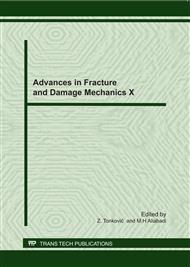[1]
S. Peuget, J.N. Cachia, C. Jégou, X. Deschanels, D. Roudil, V. Broudic, J.M. Delaye, J.M. Bart, J. Nucl. Mater. 354 (2006), p.1.
DOI: 10.1016/j.jnucmat.2006.01.021
Google Scholar
[2]
Y. Inagaki, H. Furuya, Y. Ono, K. Idemitsu, T. Banba, S. Matsumoto, S. Muraoka, Mater. Res. Soc. Symp. Proc. 294 (1993), p.191.
Google Scholar
[3]
H. Matzke, in: CEA/Varlhô Summer Session Proceedings on Glass: Scientific Research for High Performance Containment, Méjannes-Le-Clap (1997), p.149.
Google Scholar
[4]
C.L. Rountree, R.K. Kalia, E. Lidorokis, A. Nakano, L. Van Brutzel, P. Vashishta, Annu. Rev. Mater. Res. 32 (2002) p.377.
DOI: 10.1146/annurev.matsci.32.111201.142017
Google Scholar
[5]
A. Pedone, J. Phys. Chem. C 113 (2009) p.20773.
Google Scholar
[6]
J. de Bonfils, S. Peuget, G. Panczer, D. de Ligny, S. Henry, P. -Y. Noel, A. Chenet, B. Champagnon, J. Non-Cryst. Solids, 356 (2010) p.388.
DOI: 10.1016/j.jnoncrysol.2009.11.030
Google Scholar
[7]
L.H. Kieu, J.M. Delaye, L. Cormier, C. Stolz, submitted to J. Non-Cryst. Solids.
Google Scholar
[8]
G. Bureau, J. -M. Delaye, S. Peuget, G. Calas, Nucl. Instr. Meth. Phys. Res. B 266 (2008) 2707.
Google Scholar
[9]
L. Van Brutzel, Ph.D. thesis, Université Paris VI (1999).
Google Scholar
[10]
F. Célarié, S. Prades, D. Bonamy, L. Ferrero, E. Bouchaud, C. Guillot, C. Malière, Phys. Rev. Lett. 90 (2003), p.075504.
DOI: 10.1103/physrevlett.90.075504
Google Scholar
[11]
S.J.V. Frankland, V.M. Harik, G.M. Odegard, D.W. Brenner, T.S. Gates, Compos. Sci. Technol. 63 (2003) p.1655.
Google Scholar
[12]
A. Adnan, C.T. Sun, H. Mahfuz, Compos. Sci. Technol. 67 (2007), p.348.
Google Scholar
[13]
D. Stauffer, Introduction to Percolation Theory, Taylor & Francis, Washington, DC (1992).
Google Scholar
[14]
C.L. Rountree, D. Bonamy, D. Dalmas, S. Prades, R.K. Kalia, C. Guillot, E. Bouchaud, Phys. Chem. Glasses: Eur. J. Glass Sci. Technol. B 51 (2010), p.127.
Google Scholar
[15]
E. Bouchaud, J. Phys. Condens. Matter 9 (1997), p.4319.
Google Scholar
[16]
C.L. Rountree, S. Prades, D. Bonamy, E. Bouchaud, R. Kalia, C. Guillot, J. Alloy. Compd. 434-435 (2007) p.60.
DOI: 10.1016/j.jallcom.2006.08.336
Google Scholar
[17]
S. Prades, PhD thesis, Université Paris VI (2004).
Google Scholar


